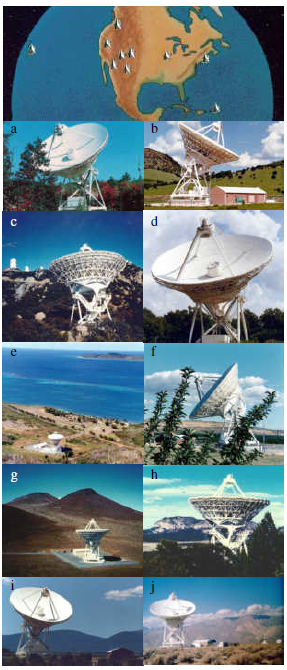
The Very Long Baseline Array (VLBA)
 المؤلف:
E. R. Huggins
المؤلف:
E. R. Huggins
 المصدر:
Physics 2000
المصدر:
Physics 2000
 الجزء والصفحة:
1036
الجزء والصفحة:
1036
 9-1-2021
9-1-2021
 2244
2244
The Very Long Baseline Array (VLBA)
To obtain significantly greater resolving power, the Very Long Baseline Array (VLBA) was set up in the early 1990’s. It consists of ten 25 meter diameter radio telescopes placed around the earth as shown in Figure (1). When the images of these telescopes are combined, the resolving power is comparable to an optical telescope 1000 meters in diameter (or an array of optical telescopes spread over an area one kilometer across).
The data from each telescope is recorded on a high speed digital tape with a time track created by a hydrogen maser atomic clock. The tapes are brought to a single location in Socorrow New Mexico where a high speed computer uses the accurate time tracks to combine the data from all the telescopes into a single image. To do this, the computer has to correct, for example, for the time difference of the arrival of the radio waves at the different telescope locations.
Because of it’s high resolution, the VLBA can be used to study the structure of individual stars. In Figure 2 we see two time snapshots of the radio emission from the stellar atmosphere of a star 1000 light years away. With any of the current optical telescopes, the image of this star is only a point.

Figure 1:The Very Long Baseline Array of radio antennas. They are located at a) Hancock New Hampshire b) Ft. Davis Texas c) Kitt Peak Arizona d) North Liberty Iowa e) St. Croix Virgin Islands f) Brewster Washington g) Mauna Kea Hawaii h) Pie Town New Mexico i) Los Alamos New Mexico j) Owen’s Valley California.

Figure 2: Standard optical microscope, which my grandfather purchased as a medical student in the 1890’s. Compare this with a microscope constructed 100 years later.
 الاكثر قراءة في مواضيع عامة في علم البصريات
الاكثر قراءة في مواضيع عامة في علم البصريات
 اخر الاخبار
اخر الاخبار
اخبار العتبة العباسية المقدسة


